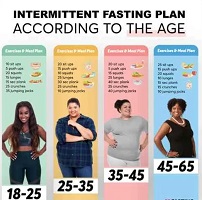Intermittent Fasting Definition ~ What is Intermittent Fasting?
Intermittent Fasting Definition ~ What is Intermittent Fasting? Please watch this short video >>>
Intermittent meaning
Occurring at irregular intervals; not continuous or consistent: occasional.
Fasting meaning
Fasting is defined as abstaining from food or drink, or both, for health, ritualistic, religious, or ethical reasons.
Intermittent Fasting Definition ~ What is Intermittent Fasting?
Intermittent fasting is a popular diet trend that involves alternating between eating and fasting times.
This diet is popular because it helps people recover control of their health while also making them feel more invigorated.
In this write-up, we will define intermittent fasting and explain how it can benefit you.
Definition of Intermittent Fasting?
What is intermittent fasting’s definition?
Intermittent fasting is the practice of not eating or drinking anything with calories for a set amount of time.
People say they appreciate this diet since it is less difficult than counting calories. You don’t have to watch calories with intermittent fasting; you just have to eat everything within a specified time limit.
What does intermediate fasting mean?
What exactly is the meaning of intermittent fasting?
Intermittent fasting means not eating for a set period each day or week. Alternate-day fasting is a popular strategy of intermittent fasting. Eat normally one day and then fast or have one tiny meal (less than 500 calories) the next.
Intermittent Fasting History
While fasting has recently gained popularity, it has been used for spiritual development and health benefits for many years.
For example, the ancient Greeks believed that eating increased one’s chances of demonic possession, hence fasting was a widespread practice.
Ramadan is another outstanding example of a 28-30-day fast during which Muslims do not eat or drink from sunrise to sundown.
Ramadan is still commonly observed, and you may know someone who keeps this fast.
Fasting has sometimes been used to express political dissatisfaction. Gandhi is known to have fasted at least 14 times as a form of peaceful protest.
Fasting was also used as a political protest by members of the Irish Republican Army. Some participants fasted for 45-61 days.
Forms of Intermittent Fasting ~ Intermittent Fasting Plans
Because there are so many variations of this dietary pattern, there is no precise definition of intermittent fasting in terms of your eating schedule.
Some of the more prominent types of intermittent fasting are alternate-day fasting, whole-day fasting, and time-restrictive eating, in which people limit the amount of time they can eat each day.
The 16/8 diet is a popular variation of time-restricted feeding in which participants fast for 16 hours straight each day and eat freely for the following 8 hours.
Time-limited feeding is arguably the most common type of fasting because it involves prolonging the overnight fast you complete while sleeping.
Longer fasting intervals, such as 24, 36, 48, and 72 hours, are not necessarily beneficial for you and may be dangerous. Going without food for an extended period may urge your body to begin storing more fat in reaction to famine.
Before beginning intermittent fasting, consult with your doctor. Once you have his or her approval, the actual practice is straightforward.
How does intermittent fasting work?
There are numerous approaches to intermittent fasting, but they all revolve around establishing regular eating and fasting times. For example, you could try eating only eight hours a day and fasting the rest of the time.
You could also choose to eat only one meal each day two days per week. There are numerous intermittent fasting schedules available.
According to Mattson, after several hours without eating, the body depletes its sugar stores and begins to burn fat. He calls this metabolic switching.
“Intermittent fasting contrasts with the normal eating pattern for most Americans, who eat throughout their waking hours,” says Mattson.
“If someone eats three meals a day plus snacks and doesn’t exercise, they’re running on those calories and not burning their fat stores every time they eat.”
Intermittent fasting works by extending the time between when your body has burnt through the calories from your last meal and begins to burn fat.
How Will You Feel While Fasting?
People who have never tried intermittent fasting are often concerned about their chances of success.
Most of us like to eat when we are hungry–sometimes it is all we can think about–and don’t feel well when we go for lengthy periods without eating.
To be honest, the first few days or even weeks may be difficult. Your body will need time to acclimatize.
However, once adjusted, people claim to not feel hungry during their fasting hours and to have increased energy and mental clarity.
If you decide to fast and are having difficulty during your fasting window, try drinking additional water and/or tea (without sweetener or milk) to aid with hunger.
What to Eat While Fasting?
What you consume during your eating window can have a significant impact on what fasting can achieve for you.
To clarify, if you just eat energy-dense and nutritionally void foods within your eating window, you may not see any changes…and you may still gain weight.
However, if you eat nutrient-dense, whole foods such as fruits, vegetables, whole grains, and lean meats, you will most certainly notice many positive benefits. Don’t get us wrong: everything has a time and a place (even cake and ice cream)…it’s all about balance.
You may be asking what you can eat during your fasting period, and the short answer is anything that doesn’t contain calories, such as water, tea, or black coffee.
The Long answer is that it depends. Some people will continue to eat while fasting, especially if the fasting period is quite long.
Some people, for example, practice modified alternate-day fasting, in which they have one modest meal (approximately 250-500 calories) on fasting days.
While the decision is solely yours, make it thoughtfully. If you decide to try a fasting program with a short fast, such as the 16/8, you should endeavor to fast for the entire window.

Why fast?
Many studies have found that intermittent fasting is an excellent method for becoming a healthier version of yourself.
These studies suggest that fasting can help patients lose body fat while also lowering their risk for a variety of metabolic diseases such as inflammation, hypertension, type 2 diabetes, and others.
Other studies demonstrate that fasting increases autophagy, which lowers the risk of neurological disorders including Alzheimer’s and Parkinson’s disease, and cancer, and slows the aging process
In a nutshell, intermittent fasting is beneficial to your overall health. Read on to learn why intermittent fasting works.
Intermittent Fasting Benefits
Here are some of the benefits of intermittent fasting that have been discovered thus far:
- Reasoning and memory. According to research, intermittent fasting improves working memory in animals and verbal memory in adults.
- Cardiovascular health. Intermittent fasting increases blood pressure, resting heart rate, and other heart-related measures.
- Physical ability. Fasting for 16 hours resulted in fat loss while retaining muscular mass in young males. Mice fed on alternate days have more endurance when running.
- Obesity and type 2 diabetes. Intermittent fasting prevented obesity in animal trials.
- Tissue well-being. Intermittent fasting reduced tissue damage and enhanced surgical outcomes in rats.
The Bottom Line
Intermittent fasting is a popular diet for losing body fat and lowering one’s chance of developing various metabolic problems.
Check out our definitive guide to intermittent fasting for more information on your fasting adventure.
Join the community of similar minds who are all experimenting with intermittent fasting if you are thinking about trying it or if you are already doing it!
Being part of a group will aid in the transition to fasting…You don’t have to go through this alone!
Cheers to a healthier and happier you!
FAQs about Intermittent Fasting Definition
Intermittent fasting for women ~ How many hours should a woman do intermittent fasting?
Here are some of the best intermittent fasting diets for women ~ Crescendo Method: Fasting for 12-16 hours two to three days per week.
Fasting days should not be consecutive and should be spread evenly throughout the week (for example, Monday, Wednesday, and Friday).
Best intermittent fasting for weight loss Which intermittent fasting method is best for weight loss?
One of the most common types of fasting for weight loss is the 16/8 intermittent fasting regimen.
The strategy restricts eating and calorie-containing beverages to an 8-hour window per day. It necessitates fasting for the remaining 16 hours of the day.
Benefits of intermittent fasting 16/8
16:8 Intermittent fasting entails fasting for 16 hours and eating all calories for the remaining 8 hours.
Weight loss and fat loss are suggested benefits of the 16:8 regimen, as well as the prevention of type 2 diabetes and other obesity-related diseases.
Intermittent fasting schedule for women ~ What is the best time for intermittent fasting for women?
Fast at the right times
Fasting is best tried a day or two after your period starts and again a week or so afterward.
You should limit your fasting times during the two weeks preceding your menstruation. You’re probably ovulating two weeks before your menstruation.
How long does 16/8 intermittent fasting take to work?
You may have to wait 2 to 4 weeks to see or feel any results.
How do you go about doing intermittent fasting? Intermittent Fasting Definition
There are numerous approaches to intermittent fasting, but they all revolve around establishing regular eating and fasting times.
For example, you could try eating only eight hours a day and fasting the rest of the time. You could also choose to eat only one meal each day two days per week.
What are the hours for intermittent fasting?
The practice of 16/8 intermittent fasting is restricting your intake of foods and calorie-containing liquids to an 8-hour window each day.
You don’t eat anything for the next 16 hours, but you can drink water and other low-calorie liquids like simple coffee or tea.
What is the difference between intermittent fasting and normal fasting?
Fasting diets are mostly concerned with the timing of when you can eat. There are numerous fasting diets, sometimes known as “intermittent fasting.”
You eat every day but only for a few hours during time-restricted feeding. As a result, you may only eat between six and eight hours every day.
What is another name for intermediate fasting?
Intermittent fasting, alternate-day fasting, reduced meal frequency, and time-restricted feeding are all phrases used to represent regular intermittent calorie abstinence.
How to reduce face fat ~ What to do to reduce facial fat
- Cardio exercise.
- Facial exercises.
- Reduce salt intake.
- Targeting facial fat.
- Reduce alcohol consumption.
- Increase water intake.
- Sleep
- Nutrition
How can I lose face fat fast?
5 Incredible Ways to Get Rid of Face Fat
- Well-Balanced Diet: A great way to lose face fat is to opt for a healthy lifestyle consisting of fresh fruits and green veggies.
- Hydration Is the Key
- Get Lots of Sleep
- Effective Facial Exercises
- Overall Weight Loss
- Lifestyle Changes
- Watch Sodium Intake
- Say No to Sugar
What is the right age for intermittent fasting?
Consult your primary care physician before attempting intermittent fasting or any other diet. There are certain folks you should not try intermittent fasting: Children and teenagers under the age of eighteen. ladies who are nursing or expecting.
Does age affect the type of intermittent fasting?
It is essential to take your age and specific requirements into account when choosing an intermittent fasting regimen. To prevent any potential dietary deficits or metabolic abnormalities, older persons may benefit from shorter fasting times, whereas younger adults may prefer longer fasting windows.
How long should a woman fast for intermittent fasting?
A dietary regimen known as intermittent fasting entails periodic, brief fasts. The 5:2 diet, modified alternate-day fasting, and daily 14–16-hour fasts are the best options for women.
How many hours should I fast for my age?
According to Hendricks, “many scientists and fasting physicians have determined that daily fasting of up to approximately 18 hours every day is safe and healthy for adults of all ages.”
Does fasting promote healthier aging?
However, there are numerous claims regarding the potential for intermittent fasting to postpone or slow down the aging process. Though it’s a compelling concept, we just don’t know enough at this time to conclude that this anti-aging impact applies to people. A large portion of the research on fasting’s anti-aging benefits has been conducted using animal models.
How many hours of fasting is safe?
The majority of fasting regimens don’t last longer than a day. Anyone who wants to extend their fast should talk to a healthcare provider about the advantages and disadvantages. During a fast, medical practitioners might advise against engaging in physically demanding or vigorous activities.
How long should a 45-year-old fast?
One of the most widely used fasting techniques is this one. consuming all of your calories during an eight-hour window and fasting for sixteen hours every day. It is recommended that women begin with a 14-hour fast and work their way up to 16 hours. This approach is adaptable and suitable for ladies with hectic schedules.
Why is 16 hours the magic number for fasting?
Your body goes through a process called autophagy—a 16-hour fast—during which it eliminates aging or damaged cells. Autophagy is the process by which cells that aid in lowering inflammation and illness are recycled throughout the body.
What is the best intermittent fasting window to lose belly fat
According to a 2023 evaluation of studies, persons who are overweight or obese can effectively reduce their weight by using the 16/8 approach or 16/8 in conjunction with calorie restriction. Eating during the window that opened before noon resulted in more weight loss than eating after noon.
Best intermittent fasting for weight loss
There are three common methods for implementing intermittent fasting:
- Fasting on alternate days. Eat a regular, healthy diet one day, then the following day, either fast entirely or just take one modest meal.
- 5-2 fasting. Eat a normal diet five days a week and fast two days per week.
- Daily time-restricted fasting.
Intermittent fasting schedule for women
16/8 technique: Eat less for the last eight hours of the day and fast for the first sixteen. For instance, eating from noon to eight o’clock or from nine a.m. to five p.m. The 14/10 approach involves just eating for the remaining 10 hours of the day after 14 hours of fasting. For instance, eating from 10 a.m. until 8 p.m.
Intermittent fasting based on BMI
According to a 2022 review that was published in Nature, adults over the age of 70, those with a history of eating disorders, children and adolescents, women who are pregnant or nursing, and those with a BMI under 18.5 are not encouraged to engage in intermittent fasting or calorie restriction in general.
Intermittent fasting chart by weight and height: How do I calculate my intermittent fasting schedule?
Easing into your fasting program is a wise method to fine-tune it. When you find a program that works best for your body, start with a 12-hour fast and work your way up from there. After determining which IF protocol is most effective for you, you can continue at this level, pay attention to your body, and make adjustments as necessary.
Intermittent fasting chart by age and weight: What age is best for intermittent fasting?
Consult your primary care physician before attempting intermittent fasting or any other diet. There are certain folks who should not try intermittent fasting: Children and teenagers under the age of eighteen. ladies who are nursing or expecting.
Intermittent Fasting Definition: 16/8 intermittent fasting
One type of intermittent fasting that is time-restricted is the 16:8 diet. It specifies a 16-hour fast before an 8-hour break for eating. Potential advantages could include fat and weight loss as well as a lower chance of contracting certain diseases.
Intermittent Fasting Definition: Best intermittent fasting schedule
Intermittent fasting with time restrictions (16:8 or 14:10). Especially for novices, one of the most popular IF techniques is time-restricted fasting. Using this strategy, you can fast for 16 or 14 hours a day and have an 8- or 10-hour eating window, respectively, according to the 16:8 or 14:10 timetable.


